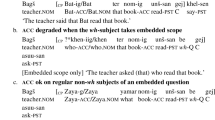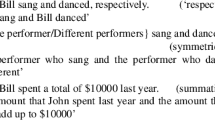Abstract
The syntax of either ... or ... treats the analyst to two main puzzles: the ‘either too high’ puzzle (either can be dissociated from the contrastive focus, surfacing in positions higher up the syntactic tree), and the ‘either too low’ puzzle (either is apparently too low in the tree, embedded inside the first disjunct). Covering data beyond the range of extant accounts, this paper presents an integrated solution to both puzzles. The paper’s central claim is that both either and or are phrasal categories. They originate in a position adjoined to their disjunct, to the contrastive focus or to a higher node on the ‘θ-path’ projected from the contrastive focus. Though either itself is immobile, its [+ NEG] counterpart, neither, can undergo phrasal movement from its base-generation site to a higher position in the tree, from which it triggers negative inversion; [+ WH] whether must move to SpecCP; and or and [+ NEG] nor must, if they are not base-generated there, front to the initial position in the second disjunct in order to be able to participate in a feature-checking relationship with the abstract head J(unction), the functional head that takes the second disjunct as its complement and the first disjunct as its specifier. The movement of whether, neither and (n)or will be diagnosed on the basis of the familiar restrictions on movement.
Similar content being viewed by others
references
Abney, Stephen(1987). The English Noun Phrase in its Sentential Aspect, Ph.D. dissertation, MIT
Baker Mark. (1988). Incorporation. University of Chicago Press, Chicago
Bayer Josef (1996). Directionality and Logical Form. Kluwer Academic Publishers, Dordrecht
Blodgett Allison. (2000). ‘Prosodic Cues “and” Syntactic Disambiguation’. OSU Working Papers in Linguistics 53: 1–30
Blodgett, Allison and Julie Boland. 1998, ‘Understanding both in Coordinate Structures: The OSU Subject Pool Both Surprised Allison and Julie!’, Poster presented at the 11th CUNY Conference on Human Sentence Processing, Rutgers University, March 1998.
Bobaljik, Jonathan(1995). Morphosyntax: The Syntax of Verbal Inflection. Ph.D. dissertation, MIT
Bošković Željko (2004). ‘Be Careful Where you Float your Quantifiers’. Natural Language and Linguistic Theory 22: 681–742
Büring, Daniel. 2002. ‘Focus Projection and Default Phonology’, Paper presented at Lund University, December 2002; ms., UCLA.
Chomsky Noam. (1971). ‘Deep Structure, Surface Structure and Semantic Interpretation’. In: Steinberg, D. and Jakobovits, J. (eds) Semantics: An Interdisciplinary Reader in Philosophy, Linguistics and Psychology, pp 183–216. Cambridge University Press, Cambridge
Chomsky Noam. (1986). Barriers. MIT Press, Cambridge, MA
Chomsky Noam. (1995). The Minimalist Program. MIT Press, Cambridge, MA
Chomsky Noam. (2001). ‘Derivation by Phase’. In: Kenstowicz, M. (eds) Ken Hale : A Life in Language., pp 1–52. MIT Press, Cambridge, MA
Culicover Peter. (1999). Syntactic Nuts. Cambridge University Press, Cambridge
Den Dikken Marcel. (1995). Particles. On the Syntax of Verb-Particle, Triadic and Causative Constructions. Oxford University Press, Oxford/New York
Den Dikken, Marcel. 2003. ‘On the Syntax of Locative and Directional Adpositional Phrases’, ms., CUNY Graduate Center.
Dougherty Ray. (1970). ‘A Grammar of Coordinate Conjoined Structures: I’. Language 46: 850–898
É. Kiss Katalin. (1998). ‘Identificational Focus Versus Information Focus’. Language 74: 245–273
É. Kiss Katalin. (2000). The Syntax of Hungarian. Cambridge University Press, Cambridge
Emonds Joseph. (1985). A Unified Theory of Syntactic Categories. Foris, Dordrecht
Gullì, Antonino. 2003. Phrasal Reduplication in Syntax, Ph.D. dissertation, CUNY Graduate Center.
Hale Kenneth. and Samuel Jay Keyser (1993). ‘On Argument Structure and the Lexical Expression of Syntactic Relations’. In: Hale, K. and Keyser, S.J. (eds) The View from Building 20., pp 55–109. MIT Press, Cambridge MA
Han Chung-hye and Maribel Romero (2004). ‘The Syntax of Whether/Q ... or Questions’. Natural Language and Linguistic Theory 22: 527–564
Hendriks Petra (2001). ‘Initial Coordination and the Law of Coordination of Likes’. In: Broekhuis, H. (eds) Linguistics in the Netherlands 2001., pp 127–138. John Benjamins, Amsterdam
Hendriks, Petra. 2003. ‘Either’ as a Focus Particle’, ms., University of Groningen.
Hendriks, Petra. 2004. ‘Either, Both and Neither in Coordinate Structures’, ms., University of Groningen.
Higginbotham James. (1985). ‘On Semantics’. Linguistic Inquiry 16: 547–593
Higginbotham James. (1991). ‘Either/or’. In: Sherer, T. (eds) Proceedings of the North East Linguistic Society, Vol. 21, pp 143–155. GLSA Publications, Amherst, MA
Hoeksema Jack. and Frans Zwarts (1991). ‘Some Remarks on Focus Adverbs’. Journal of Semantics 8: 51–70
Hoekstra Teun. (1988). ‘Small Clause Results’. Lingua 74: 101–139
Jackendoff Ray. (1972). Semantic Interpretation in Generative Grammar. MIT Press, Cambridge, MA
Jespersen Otto. (1961). A Modern English Grammar on Historical Principles, George Allen & Unwin London. Ejnar Munksgaar, Copenhagen.
Johannessen Janne Bondi. (1998). Coordination. Oxford University Press, Oxford/New York
Johannessen Janne Bondi. (2005). ‘The Syntax of Correlative adverbs’. Lingua 115: 419–443
Kayne Richard. (1975). French Syntax. The Transformational Cycle. MIT Press, Cambridge, MA
Kayne Richard. (1984). Connectedness and Binary Branching. Foris, Dordrecht
Kayne Richard. (1994). The Antisymmetry of Syntax. MIT Press, Cambridge, MA
Kayne Richard. (1998). ‘Overt vs Covert Movement’, Syntax 1, 128–191 (Reprinted in Richard Kayne, 2000, Parameters and Universals. Oxford University Press, Oxford/New York. pp. 223–281
Kenesei István. (1986). ‘On the Logic of Hungarian Word Order’. In: Abraham, W. (eds) Topic, Focus and Configurationality., pp 143–159. John Benjamins, Amsterdam
Klima Edward. (1964). ‘Negation in English’. In: Fodor, J. and Katz, J. (eds) The Structure of Language: Readings in the Philosophy of Language., pp 246–323. Prentice-Hall, Englewood Cliffs, NJ
Koopman, Hilda. 1997. ‘Prepositions, Postpositions, Circumpositions and Particles: The Structure of Dutch PPs’, ms., UCLA (available on-line at: http://www.linguistics.ucla.edu/people/koopman/papers/pp.pdf).
Larson Richard. (1985). ‘On the Syntax of Disjunction Scope’. Natural Language and Linguistic Theory 3: 217–264
Lechner Winfried. (2000). ‘Bivalent Coordination in German’. Snippets 1: 11–12
Lipták, Anikó. 2001. On the Syntax of Wh-items in Hungarian, Ph.D. dissertation, University of Leiden
Manzini Rita. and Anna Roussou. (2000). ‘A Minimalist Theory of A-movement and Control’. Lingua 110: 409–447
Marantz, Alec. 1997. ‘No Escape from Syntax: Don’t Try Morphological Analysis in the Privacy of Your Own Lexicon’, in A. Dimitriadis et al. (eds.), Penn Working Papers in Linguistics, Vol. 4, pp. 201–225
McCawley James. (1996). ‘The Focus and Scope of Only ’. In: Partee, B. and Sgall, P. (eds) Discourse and Meaning. Papers in Honor of Eva Hajicová, pp 171–193. John Benjamins, Amsterdam
Munn, Alan(1993). Topics in the Syntax and Semantics of Coordinate Structures, Ph.D. dissertation. University of Maryland, College Park
Neijt Anneke. (1979). Gapping: A Contribution to Sentence Grammar. Foris, Dordrecht
Radford Andrew. (1997). Syntactic Theory and the Structure of English: A Minimalist Approach. Cambridge University Press, Cambridge
Rochemont Michael. (1986). Focus in Generative Grammar. John Benjamins, Amsterdam
Rooth, Mats(1985). Association with Focus, Ph.D. dissertation. University of Massachusetts, Amherst
Ross, John Robert. 1984. ‘Inner Islands’, in C. Brugman and M. Macaulay (eds.), Proceedings of the 10th Annual Meeting of the Berkeley Linguistics Society, pp. 258–265.
Sag Ivan., Gerald Gazdar, Thomas Wasow and Steven Weisler (1985). ‘Coordination and How to Distinguish Categories’. Natural Language and Linguistic Theory 3: 117–171
Schwarz Bernhard. (1999). ‘On the Syntax of Either ... or’. Natural Language and Linguistic Theory 17: 339–370
Schwarzschild Roger. (1999). ‘Givenness, AvoidF and other Constraints on the Placement of Accents’. Natural Language Semantics 7: 141–177
Selkirk Lisa. (1984). Phonology and Syntax: The Relation between Sound and Structure. MIT Press, Cambridge, MA
Selkirk Lisa. (1995). ‘Sentence Prosody: Intonation, Stress and Phrasing’. In: Goldsmith, J. (eds) The Handbook of Phonological Theory., pp 550–569. Blackwell, Oxford
Selkirk, Lisa. 2003. ‘Focus Prosody: Interface Economy and Surface Enhancement’, abstract of a paper presented at Yale University, available on-line at: http://www.yale.edu/linguist/SelkirkAbstract.doc.
Stowell, Tim. 1981. Origins of Phrase Structure, Ph.D. dissertation, MIT.
Van Riemsdijk, Henk 1978. A Case Study in Syntactic Markedness, The Peter de Ridder Press, Lisse.
Wesche, Birgit, 1995. Symmetric Coordination. An Alternative Theory of Phrase Structure. Linguistische Arbeiten, Max Niemeyer Verlag, Tübingen.
Wilder Chris. (1997). ‘Some Properties of Ellipsis in Coordination’. In: Alexiadou, A. and Hall, T.A. (eds) Studies on Universal Grammar and Typological Variation., pp 59–107. John Benjamins, Amsterdam
Williams Edwin. (1981). ‘Argument structure and morphology’. The Linguistic Review 1: 81–114
Zwart Jan-Wouter. (2005). ‘Verb Second as a Function of Merge’. In: den Dikken, M. and Tortora, C. (eds) The Function of Function Words and Functional Categories., pp 11–40. John Benjamins, Amsterdam
Author information
Authors and Affiliations
Corresponding author
Additional information
Part of the material for this paper was first presented in a seminar co-taught with Janet Fodor at the CUNY Graduate Center in the spring of 2003. An immediate predecessor of the present text was delivered at the 28th GLOW Colloquium in Geneva, Switzerland, on 1 April 2005. I thank the audiences present on both occasions for their generous feedback. I am very grateful to Anikó Lipták for carefully reading and meticulously commenting on earlier versions of the paper. Many thanks are also due to the anonymous reviewers for NLLT, as well as to editor Peter Culicover. Their invaluable input has led to substantial improvements of the analysis and to refinements of the empirical material. The responsibility for the final product is mine alone.
Rights and permissions
About this article
Cite this article
Dikken, M.D. Either-Float and the Syntax of Co-or-dination. Nat Language Linguistic Theory 24, 689–749 (2006). https://doi.org/10.1007/s11049-005-2503-0
Received:
Revised:
Published:
Issue Date:
DOI: https://doi.org/10.1007/s11049-005-2503-0




